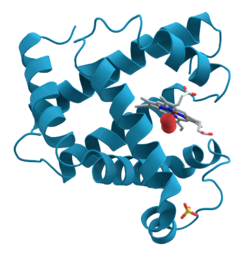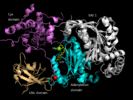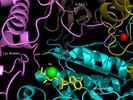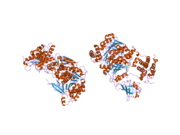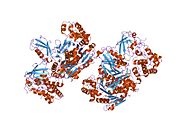Biology:UBA2
Ubiquitin-like 1-activating enzyme E1B (UBLE1B) also known as SUMO-activating enzyme subunit 2 (SAE2) is an enzyme that in humans is encoded by the UBA2 gene.[1]
Posttranslational modification of proteins by the addition of the small protein SUMO (see SUMO1), or sumoylation, regulates protein structure and intracellular localization. SAE1 and UBA2 form a heterodimer that functions as a SUMO-activating enzyme for the sumoylation of proteins.[1][2]
Structure
DNA
The UBA2 cDNA fragment 2683 bp long and encodes a peptide of 640 amino acids.[2] The predicted protein sequence is more analogous to yeast UBA2 (35% identity) than human UBA3 or E1 (in ubiquitin pathway). The UBA gene is located on chromosome 19.[3]
Protein
Uba2 subunit is 640 aa residues long with a molecular weight of 72 kDa.[4] It consists of three domains: an adenylation domain (containing adenylation active site), a catalytic Cys domain (containing the catalytic Cys173 residue participated in thioester bond formation), and a ubiquitin-like domain. SUMO-1 binds on Uba2 between the catalytic Cys domain and UbL domain.[5]
Mechanism
SUMO activating enzyme (E1, heterodimer of SAE1 and UBA2) catalyzes the reaction of activating SUMO-1 and transferring it to Ubc9 (the only known E2 for SUMOylation). The reaction happens in three steps: adenylation, thioester bond formation, and SUMO transfer to E2. First, the carboxyl group of SUMO C-terminal glycine residue attacks ATP, forming SUMO-AMP and pyrophosphate. Next, the thiol group of a catalytic cysteine in the UBA2 active site attacks SUMO-AMP, forming a high energy thioester bond between UBA2 and the C-terminal glycine of SUMO and releasing AMP. Finally, SUMO is transferred to an E2 cysteine, forming another thioester bond.[5][6][7]
Function
Ubiquitin tag has a well understood role of directing protein towards degradation by proteasome.[8] The role SUMO molecules play are more complicated and much less well understood. SUMOylation consequences include altering substrate affinity for other proteins or with DNA, changing substrate localization, and blocking ubiquitin binding (which prevents substrate degradation). For some proteins, SUMOylation doesn’t seem to have a function.[6][9]
NF-kB
Transcription factor NF-kB in unstimulated cells is inactivated by IkBa inhibitor protein binding. The activation of NF-kB is achieved by ubiquitination and subsequent degradation of IkBa. SUMOylation of IkBa has a strong inhibitory effect on NF-kB-dependent transcription. This may be a mechanism for cell to regulate the number of NF-kB available for transcriptional activation.[10]
p53
Transcription factor p53 is a tumor suppressor acting by activating genes involved in cell cycle regulation and apoptosis. Its level is regulated by mdm2-dependent ubiquitination. SUMOylation of p53 (at a distinct lysine residue from ubiquitin modification sites) prevents proteasome degradation and acts as an additional regulator to p53 response.[11]
Expression and regulation
Studies of yeast budding and fission have revealed that SUMOylation may be important in cell cycle regulation.[12] During a cell cycle, the UBA2 concentration doesn't undergo substantial change while SAE1 level shows dramatic fluctuation, suggesting regulation of SAE1 expression rather than UBA2 might be a way for cell to regulate SUMOylation. However, at time points when SAE1 levels are low, little evidence of UBA2-containing protein complexes are found other than SAE1-UBA2 heterodimer. One possible explanation would be that these complexes exist only for a short period of time, thus not obvious in cell extracts. UBA2 expression is found in most organs including the brain, lung and heart, indicating probable existence of SUMOylation pathway in these organs. An elevated level of UBA2 (as well as all other enzyme components of the pathway) is found in testis, suggesting possible role for UBA2 in meiosis or spermatogenesis. Inside the nucleus, UBA2 is distributed throughout nuclei but not found in nucleoli, suggesting SUMOylation may occur primarily in nuclei. Cytoplasmic existence of SAE 1 and UBA2 is also possible and is responsible for conjugation of cytoplasmic substrates.[13]
Interactions
SAE2 has been shown to interact with
References
- ↑ Jump up to: 1.0 1.1 "Entrez Gene: ubiquitin-like modifier activating enzyme 2". https://www.ncbi.nlm.nih.gov/sites/entrez?db=gene&cmd=retrieve&list_uids=10054.
- ↑ Jump up to: 2.0 2.1 "In vitro SUMO-1 modification requires two enzymatic steps, E1 and E2". Biochem. Biophys. Res. Commun. 254 (3): 693–8. January 1999. doi:10.1006/bbrc.1998.9995. PMID 9920803.
- ↑ Jump up to: 3.0 3.1 3.2 "Molecular cloning and characterization of human AOS1 and UBA2, components of the sentrin-activating enzyme complex". FEBS Lett. 448 (1): 185–9. April 1999. doi:10.1016/S0014-5793(99)00367-1. PMID 10217437.
- ↑ Jump up to: 4.0 4.1 "Identification of the enzyme required for activation of the small ubiquitin-like protein SUMO-1". J. Biol. Chem. 274 (15): 10618–24. April 1999. doi:10.1074/jbc.274.15.10618. PMID 10187858.
- ↑ Jump up to: 5.0 5.1 "Structures of the SUMO E1 provide mechanistic insights into SUMO activation and E2 recruitment to E1". EMBO J. 24 (3): 439–51. February 2005. doi:10.1038/sj.emboj.7600552. PMID 15660128.
- ↑ Jump up to: 6.0 6.1 "Protein modification by SUMO". Annu. Rev. Biochem. 73: 355–82. 2004. doi:10.1146/annurev.biochem.73.011303.074118. PMID 15189146.
- ↑ "Insights into the ubiquitin transfer cascade from the structure of the activating enzyme for NEDD8". Nature 422 (6929): 330–4. March 2003. doi:10.1038/nature01456. PMID 12646924. Bibcode: 2003Natur.422..330W.
- ↑ "SUMO, ubiquitin's mysterious cousin". Nat. Rev. Mol. Cell Biol. 2 (3): 202–10. March 2001. doi:10.1038/35056591. PMID 11265250.
- ↑ "SP-RING for SUMO: new functions bloom for a ubiquitin-like protein". Cell 107 (1): 5–8. October 2001. doi:10.1016/S0092-8674(01)00519-0. PMID 11595179.
- ↑ "SUMO-1 modification of IkappaBalpha inhibits NF-kappaB activation". Mol. Cell 2 (2): 233–9. August 1998. doi:10.1016/S1097-2765(00)80133-1. PMID 9734360.
- ↑ "SUMO-1 modification activates the transcriptional response of p53". EMBO J. 18 (22): 6455–61. November 1999. doi:10.1093/emboj/18.22.6455. PMID 10562557.
- ↑ "Ubc9p and the conjugation of SUMO-1 to RanGAP1 and RanBP2". Curr. Biol. 8 (2): 121–4. January 1998. doi:10.1016/S0960-9822(98)70044-2. PMID 9427648.
- ↑ "Expression and regulation of the mammalian SUMO-1 E1 enzyme". FASEB J. 15 (10): 1825–7. August 2001. doi:10.1096/fj.00-0818fje. PMID 11481243.
- ↑ "Towards a proteome-scale map of the human protein-protein interaction network". Nature 437 (7062): 1173–8. October 2005. doi:10.1038/nature04209. PMID 16189514. Bibcode: 2005Natur.437.1173R.
- ↑ Jump up to: 15.0 15.1 "Large-scale mapping of human protein-protein interactions by mass spectrometry". Mol. Syst. Biol. 3 (1): 89. 2007. doi:10.1038/msb4100134. PMID 17353931.
- ↑ "Role of an N-terminal site of Ubc9 in SUMO-1, -2, and -3 binding and conjugation". Biochemistry 42 (33): 9959–69. August 2003. doi:10.1021/bi0345283. PMID 12924945.
- ↑ "Ubc9 sumoylation regulates SUMO target discrimination". Mol. Cell 31 (3): 371–82. August 2008. doi:10.1016/j.molcel.2008.05.022. PMID 18691969.
Further reading
- "The nucleoporin RanBP2 has SUMO1 E3 ligase activity". Cell 108 (1): 109–20. 2002. doi:10.1016/S0092-8674(01)00633-X. PMID 11792325.
- "A mechanism for inhibiting the SUMO pathway". Mol. Cell 16 (4): 549–61. 2004. doi:10.1016/j.molcel.2004.11.007. PMID 15546615.
- "A human protein-protein interaction network: a resource for annotating the proteome". Cell 122 (6): 957–68. 2005. doi:10.1016/j.cell.2005.08.029. PMID 16169070.
- "A general approach for investigating enzymatic pathways and substrates for ubiquitin-like modifiers". Arch. Biochem. Biophys. 453 (1): 70–4. 2006. doi:10.1016/j.abb.2006.03.002. PMID 16620772. https://zenodo.org/record/1258674.
- "Towards a proteome-scale map of the human protein-protein interaction network". Nature 437 (7062): 1173–8. 2005. doi:10.1038/nature04209. PMID 16189514. Bibcode: 2005Natur.437.1173R.
- "Ubc9 sumoylation regulates SUMO target discrimination". Mol. Cell 31 (3): 371–82. 2008. doi:10.1016/j.molcel.2008.05.022. PMID 18691969.
- "Isoform-specific monobody inhibitors of small ubiquitin-related modifiers engineered using structure-guided library design". Proc. Natl. Acad. Sci. U.S.A. 108 (19): 7751–6. 2011. doi:10.1073/pnas.1102294108. PMID 21518904. Bibcode: 2011PNAS..108.7751G.
- "Importin α/β mediates nuclear import of individual SUMO E1 subunits and of the holo-enzyme". Mol. Biol. Cell 22 (5): 652–60. 2011. doi:10.1091/mbc.E10-05-0461. PMID 21209321.
- "Regulation of SUMOylation by reversible oxidation of SUMO conjugating enzymes". Mol. Cell 21 (3): 349–57. 2006. doi:10.1016/j.molcel.2005.12.019. PMID 16455490.
- "Structures of the SUMO E1 provide mechanistic insights into SUMO activation and E2 recruitment to E1". EMBO J. 24 (3): 439–51. 2005. doi:10.1038/sj.emboj.7600552. PMID 15660128.
- "Expression and regulation of the mammalian SUMO-1 E1 enzyme". FASEB J. 15 (10): 1825–7. 2001. doi:10.1096/fj.00-0818fje. PMID 11481243.
- "CGI-55 interacts with nuclear proteins and co-localizes to p80-coilin positive-coiled bodies in the nucleus". Cell Biochem. Biophys. 44 (3): 463–74. 2006. doi:10.1385/CBB:44:3:463. PMID 16679534.
- "APOBEC3G-UBA2 fusion as a potential strategy for stable expression of APOBEC3G and inhibition of HIV-1 replication". Retrovirology 5: 72. 2008. doi:10.1186/1742-4690-5-72. PMID 18680593.
- "Role of an N-terminal site of Ubc9 in SUMO-1, -2, and -3 binding and conjugation". Biochemistry 42 (33): 9959–69. 2003. doi:10.1021/bi0345283. PMID 12924945.
- "Large-scale characterization of HeLa cell nuclear phosphoproteins". Proc. Natl. Acad. Sci. U.S.A. 101 (33): 12130–5. 2004. doi:10.1073/pnas.0404720101. PMID 15302935. Bibcode: 2004PNAS..10112130B.
External links
- UBA2 human gene location in the UCSC Genome Browser.
- UBA2 human gene details in the UCSC Genome Browser.
 |
